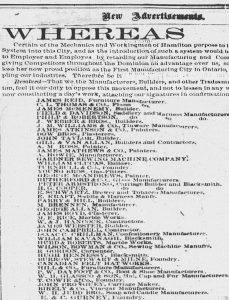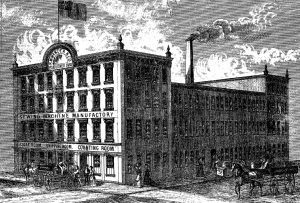The Bosses Respond
Hamilton employers weren’t all against the idea of a nine-hour work day. In fact, a number of them spoke in support of the movement at the mass meeting in January at the Mechanics’ Institute and, later, throughout the struggle. One of their concerns, however, was that instituting the nine-hour workday only in Hamilton would mean that the city’s factories could not be competitive with producers in other cities and towns. Some bosses supported the nine-hour workday in principle, but disagreed with the strategies and tactics of Ryan and the Hamilton Nine-Hour League.

A segment of the advertisement taken out in the Hamilton Spectator by merchants who opposed the Nine-Hour League.
A few bosses did grant their workers the nine-hour day, but the majority closed ranks against the Nine-Hour League. By mid-February, many of Hamilton’s prominent factory owners had signed a pledge against the Nine-Hour League. The pledge declared that the movement would “be most disastrous for alike to Employers and Employees by retarding our Manufacturing and Commercial Advancement, giving Competitors throughout the Dominion an advantage over us.” More than 144 Hamilton employers signed the pledge, which was printed in the Hamilton Spectator on February 19, 1872.
When they received news that the Nine-Hour League planned to shut down production in the city on May 15th, some employers took more drastic action. R.M. Wanzer pre-emptively locked out employees at his sewing machine factory on May 10, 1872. The next day, the owners of many of the city’s metal foundries followed suit. On the eve of the parade, the battle lines were drawn.


